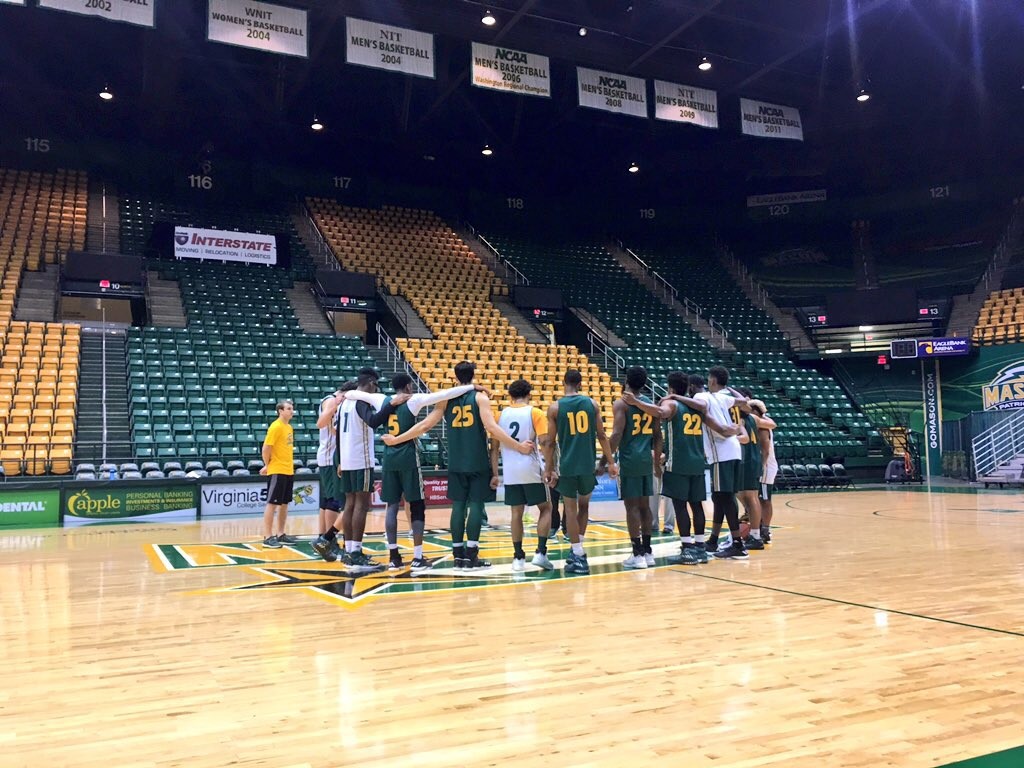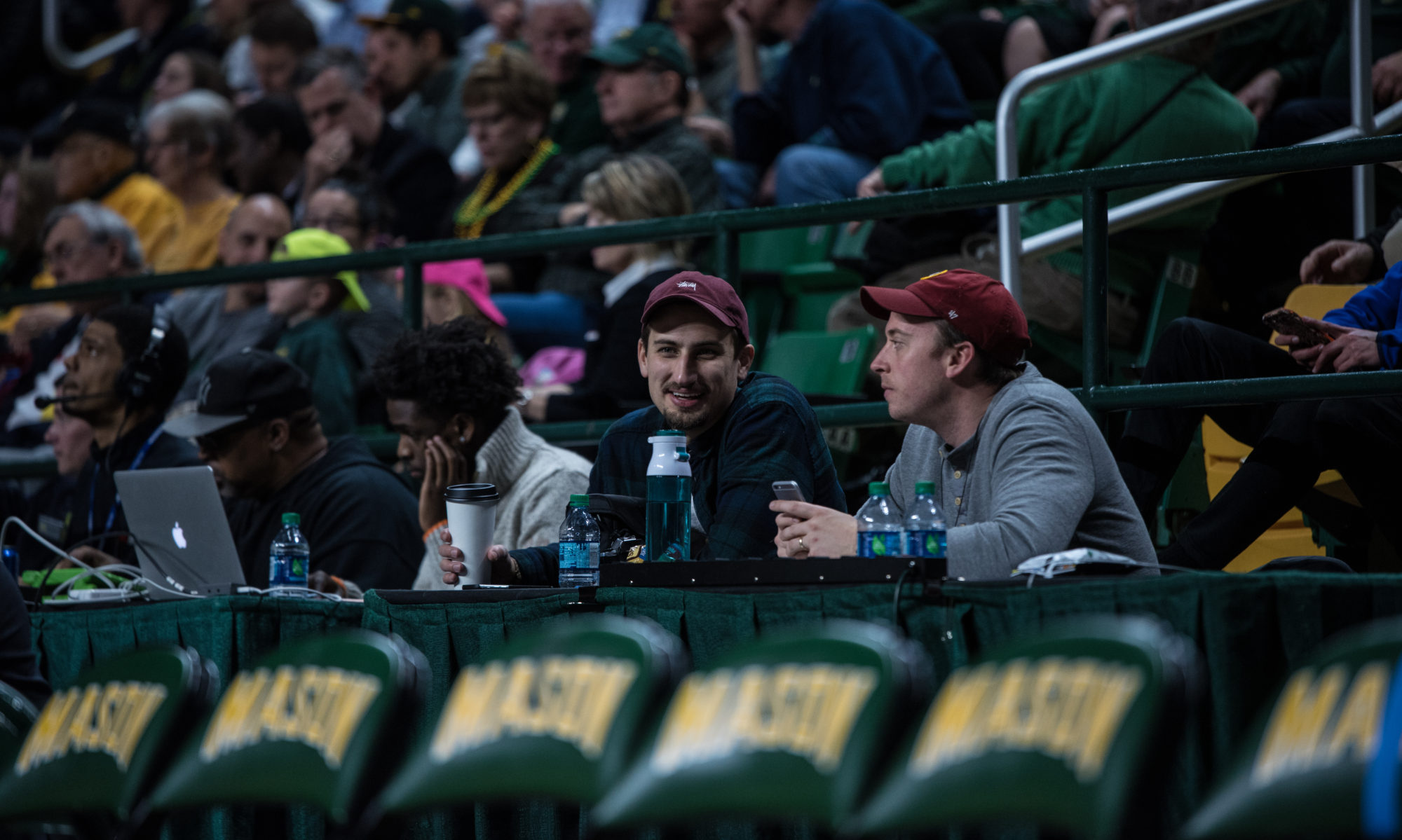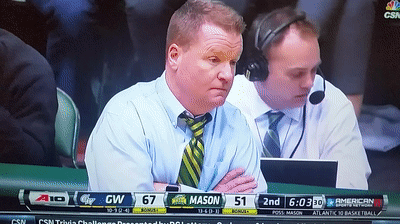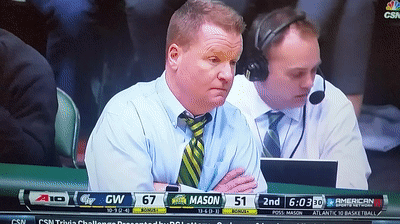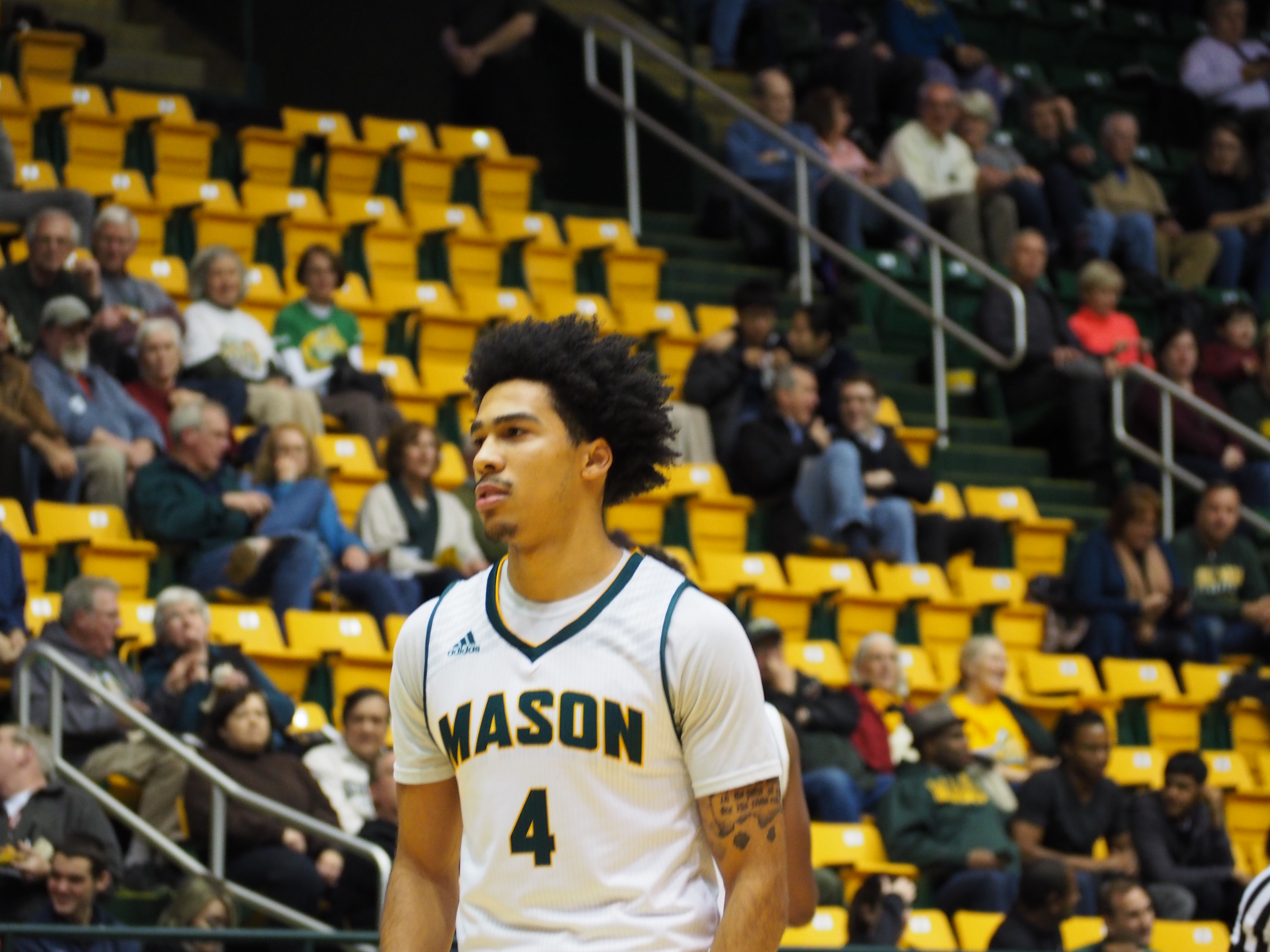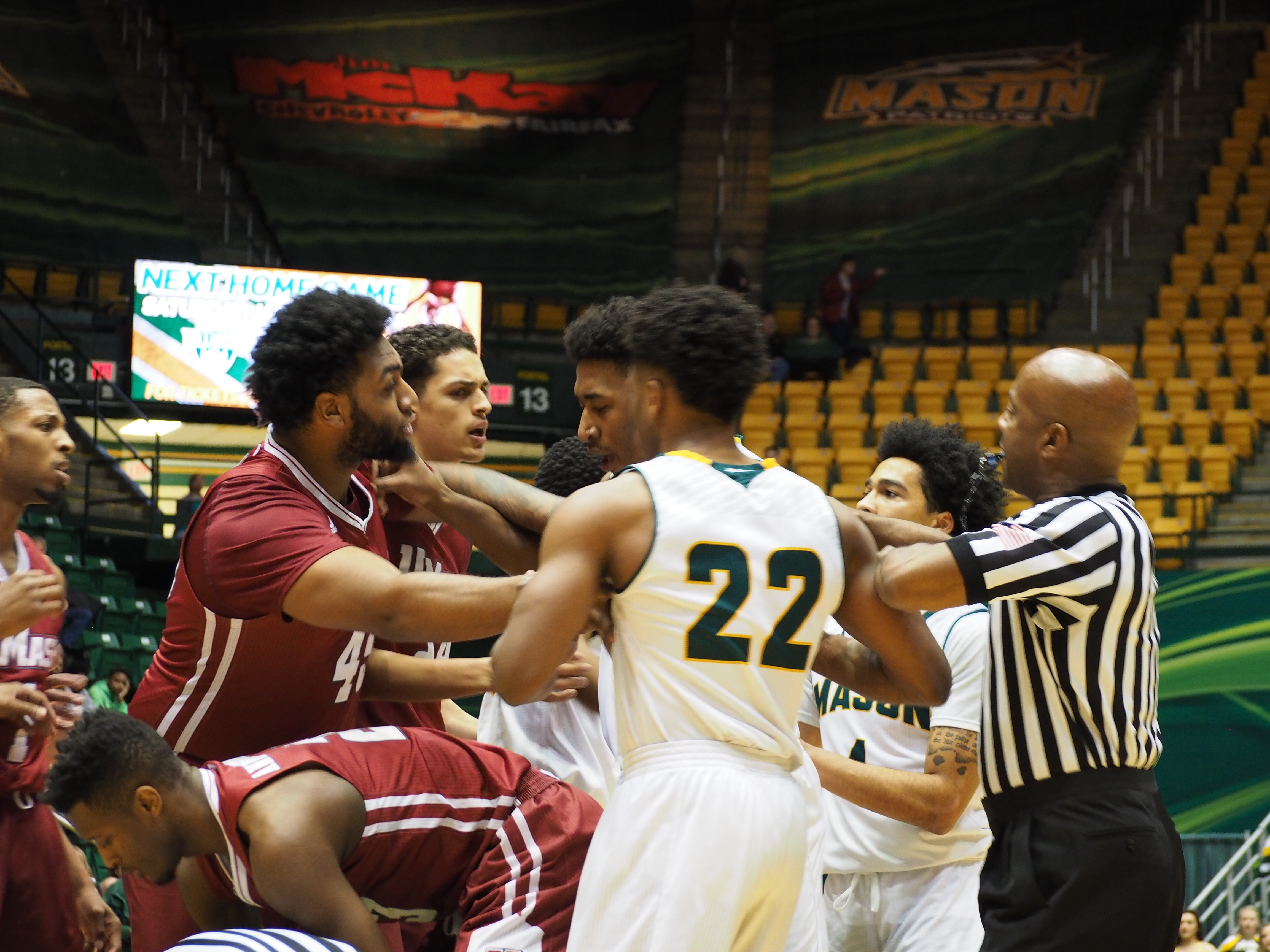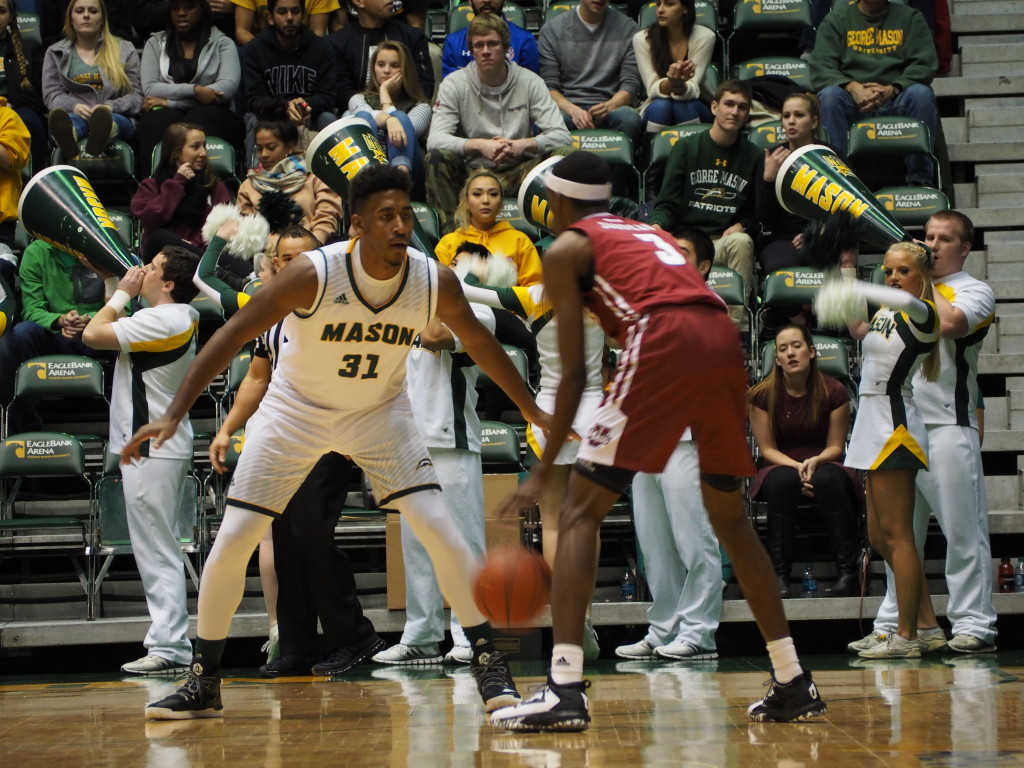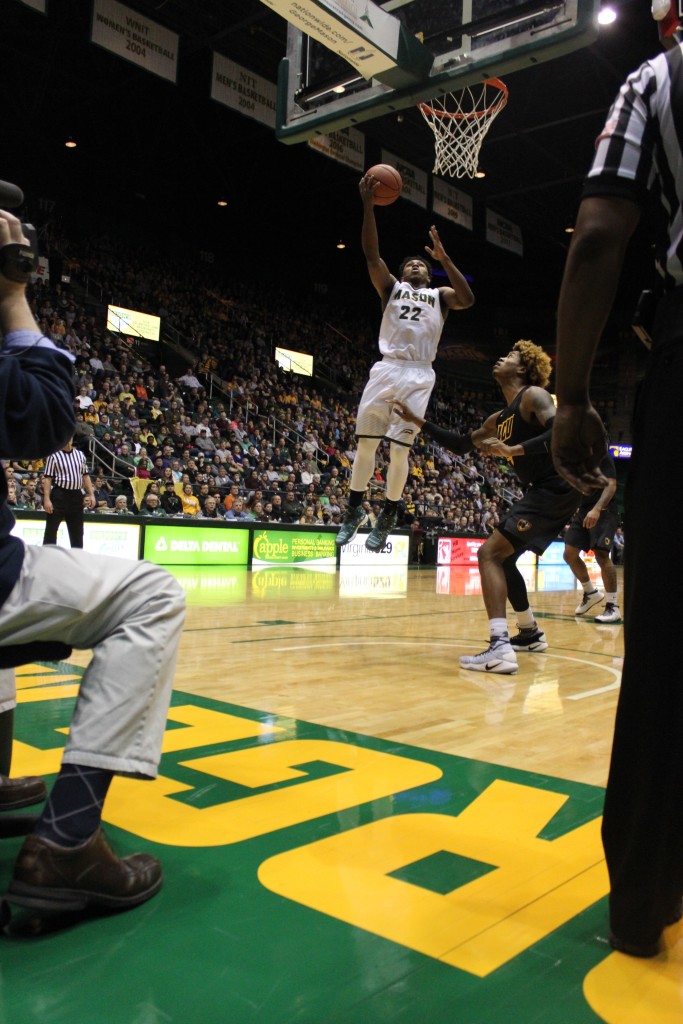1/16/17 – The Breakdown
by: Petey Buckets
Welcome to the first edition of Petey’s Bucket of Knowledge. For those of you who don’t know me, I’m sort of a Mason basketball hipster die hard. One of the first things I did when I got to campus was join the Patriot Platoon, and my freshman year turned out to be the final four season. I’ve had season tickets since I graduated eight years ago. I post a lot on the masonhoops boards, and the By George guys asked me to start doing recaps, which you may have seen, and those recaps have turned into this weekly breakdown in front of you right now. Who needs another recap writer, right?
Despite being a big basketball nerd, I don’t have a playing or coaching career to speak of. I’ve always been drawn to basketball as a fan, and I find the intersection of statistics and strategy fascinating. I’ve acquired everything I know about basketball by watching as many games as I can at all levels, and by reading copious amounts of analysis from all sorts of authorities. I like to be able to explain what I’m seeing on the court using statistics, x’s, and o’s. It’s not usually enough for me to know that a team or a player is playing well – I want to know how and why, and it’s my goal to use this forum to share those thoughts.
I want to be the first to acknowledge that you can fill encyclopedias with everything I don’t know about basketball. I am purely a fanalyst, and not an expert of any sort. That said, these posts should still be fun, informative, and will hopefully help all of us increase our understanding of Mason basketball. These will be heavy on stats and visual analysis, so they aren’t for everyone, but I hope you’ll like them. Leave a comment or find me on twitter (@peteybuckets) and we can talk hoops. Now let’s get to this week’s breakdown. I’ll do two sections – chalk talk and stats – so if one section is boring you skip down to the next and maybe that’ll be better.
Chalk Talk
First we gotta talk about how St. Joe’s chose to defend Mason with Marquise on the floor. Marquise’s defender was basically playing a one-man zone as an extra body in the paint when Marquise was off the ball. Teams usually give Marquise plenty of space on the perimeter, but St. Joe’s took it to an extreme.
Demery (25) is guarding Marquise here. Marquise is above the three point line, about to get the ball. Demery is in the middle of the paint, going about eight feet under the screen:

Here’s Demery again basically playing a one-man zone when Marquise is off the ball. Demery is #25 in the middle of the paint. Marquise is out beyond the three point line. From this still it looks like St Joe’s might be in zone, but they are not:

Mason got Marquise moving in some other ways, including having him off the ball while Otis initiated the pick and roll. Here Otis and Relvao start the pick and roll. Marquise has only just crossed halfcourt:

Casper and Kimble switch, so Casper, a forward, is caught guarding Otis at the three point line when Otis kicks to Marquise. Marquise only has Demery in front of him:

Casper hesitates to leave Otis, and it’s already too late. From the setup above, Marquise barrels into the paint and gets this shot plus the foul:

St. Joe’s was also sagging off shooters pretty hard. Look at the three weakside defenders here. Five of their six combined feet are in the paint. Again it looks like it might be a zone, but it’s not. It’s man defense with an aggressive eye toward help defense. They seem utterly unconcerned about Mason shooting threes:

Marquise adjusted to this look in the second half – he had 9 points and 2 assists in the first, and 15 points and 5 assists in the second. This screenshot started as a pick and roll with Marquise and Relvao – both defenders chase Relvao into the paint, which is a moronic choice, and leave Marquise wide open at the free throw line. I don’t know if this was a miscommunication on a switch, or if Demery was conceding jumpers to cut off the paint, but either way Marquise hits this:

Here’s a possession that starts with Relvao setting a simple ball screen. Marquise gets a step on Demery and charges into the paint. Charlie Brown’s help is late (circled), and Marquise gets an easy layup over the guard who slid into the paint:

A couple possessions later we run the exact same play. This time Charlie Brown is faced with the same decision – leave a shooter to help, or stay home. He chooses to help. Good grief. Marquise hits Jaire (circled in blue), who drains the catch-and-shoot three:

Later in the half, the action starts in the same spot on the floor. Casper is circled in red – he’s guarding Kier (blue), but he started the possession as an extra paint defender, a full 15+ feet away from Kier. Marquise penetrates, sees Kier wide open, and Kier drains a three that’s as wide open as he’ll see all season.

I would like to introduce this as evidence in Marquise Moore’s case for A-10 player of the year. He’s absolutely wreaking havoc on St. Joe’s. When they guard him one-on-one, he scores. When they double him, he finds open shooters. This is textbook stuff that sounds simple but is all predicated on Marquise’s exceptional ability to get into the paint despite defenses diverting their resources to prevent him from doing that. He’s been brilliant all season long and the truth is that Mason is probably a somewhere between a ten or twelve win team on the season without him.
Some other tactical notes:
It’s no secret that the team struggles when Jalen goes to the bench, so I paid attention to Relvao and Temara to get an idea of what exactly they’re doing or not doing. There are some freshman mistakes here, but nothing that can’t be fixed with more time in the system.
Here is Relvao catching an entry pass with great position on a much smaller defender, the 6’0” Kimble. You almost can’t see Kimble in this shot because he’s entirely to Relvao’s left. If Relvao turns to his right, he’s got an easy layup at the rim, but he’ll have to finish it with his left. Instead, he turns left (to finish with his right) and gets fouled. This is a small thing, but worth noting. Plenty of college bigs are Zoolanders (can’t ambi-turn) but if Relvao is going to reach his potential here he’ll need to finish great looks like this without relying on fouls. The foul isn’t a bad result, but a clean look in the paint like this should be an easy two or an and-one opportunity.

Here’s an instance where his help defense is really slow. You can see Chris Clover is in the paint and driving – Relvao is flat footed and below the charge arc. On a drive like this we want the big to close off the paint and make the driving player either pass or contest the finish. Since Relvao isn’t there, Boyd ends up fouling Clover to prevent the easy bucket.

Now here’s Temara defending a screen to the wrong side. Agbeko (St Louis) feints a screen to Marquise’s right and Temara reacts. Agbeko instead screens to Marquise’s left, and Temara is too slow to adjust. With Marquise effectively screened and Temara out of position, this becomes a layup for the St. Louis ballhandler:

St Louis also had a nice play drawn up to take advantage of our freshman bigs. Agbeko charges toward the ballhandler as if he’s setting a ball screen, then cuts to the basket instead. This play beat the defense twice. In this shot, Temara gets way out of position by following Agbeko over, probably because he assumes it’s a ball screen:

Here’s the look Agbeko gets off the pass. One dribble and he has an easy reverse layup:

They ran the exact same play against Relvao a few minutes later and got the exact same result:

St. Louis also ran a nice play that took advantage of our tendency to switch. Here, Agbeko screens for Crawford (St. Louis). Karmari gets switched onto Agbeko and chases him into the paint. Jaire, who is guarding Welmer on the perimeter, leaves to help cover Agbeko:

The result is this wide open three by Welmer, who drills it:

Since St. Bonaventure murdered us by getting the ball into the post quickly after ball screens, to take advantage of the paint when our bigs were high, I wanted to see if we made any changes to how we hedged. The answer is not really. Our bigs were still hedging very high, but Saint Joe’s didn’t have the bigs to make us pay for it. Here’s a simple ball screen with Casper (circled red) setting the screen. Relvao hedges damn near to half court, leaving just The People’s Rebounder patrolling the paint. There are plenty of instances of this happening in the St. Louis game as well:

Upon review of the St. Louis game, the freshmen had some trouble with defensive rotations. I’ve got one last collage to illustrate. Here, Karmari doubles the post, then runs out to the perimeter on the kickout. All good so far:

However, as soon as he gets there he turns to start running to the far side to cover 24, who’s all alone. This is a standard part of our rotation (the guard who doubles rotates out to the far side shooter after the other defenders all rotates over one) but here you see a problem:

Karmari is running away but Kier isn’t sliding over. The Saint Louis player gets a drive directly into the paint. Since no one replaced Karmari, Jalen is left all alone to contest the layup. Jalen actually forces a miss here, but SLU gets an offensive rebound and a putback:

This sort of thing happened frequently, and not just to Karmari (though this might explain why Karmari got only ten minutes in a game where we desperately needed offense). It’s part of the growing pains of playing with a youth-heavy lineup, and it’s part of the reason Mason isn’t good enough to win on off nights like against St Louis.
Stats
We’ll start with some per-game conference play only stats here.
Marquise Moore: 18 points on 12.4 FGA, 10.2 rebounds, 4.6 assists, 1.4 steals, 0.6 blocks.
Marquise’s ability to get to the free throw line has contributed to his efficiency – his 18 points come on only 12.4 shots per game, as he’s getting just under 8 free throw attempts per game as well. You can see the rest of his stat line shows how incredibly well-rounded his game is. Per college basketball reference, he’s one of two players in the country averaging 18 points, 10 rebounds, 4.5 assists, and 1 steal in conference play:
http://tinyurl.com/hxny5va
Jaire Grayer: 13.8 points on 11 FGA, 40.7% from three, 6.2 rebounds, 1.2 blocks.
Jaire is actually leading the team in blocks and is second in rebounds in conference play. He’s also had a very nice bump in efficiency, averaging 1.25 points per shot after averaging less than 1 in the out of conference slate. All of these are welcome developments – the team gets closer to reaching its potential when Jaire scores well, and his ability to rebound and alter shots at the rim has gone a long way toward keeping the four guard lineup viable defensively.
Jalen Jenkins: 11.6 points on 8.8 FGA, 5.4 rebounds, 3.6 fouls
Jalen has been unusually quiet in conference play so far, and foul trouble has been a big part of it. He spent large parts of the VCU and St Louis games in foul trouble, and he fouled out with three minutes remaining against St Joe’s. There’s a lot of pressure on him as the lone big in the lineup, so we’ll see if his foul issues get better as the season progresses.
Otis Livingston: 10.6 points on 11 FGA, 2.6 assists, 1.6 steals
Otis was on fire during the nine game win streak, but his shot has abandoned him in conference play. He’s shooting 25.5% overall – 26.9% from three and 24.1% from inside the arc. I think he’s just going through a little funk right now and he’ll be fine. It was great to see him step up and hit that big three against St Joe’s after struggling to score all game, and he also had two huge steals in the final minutes. He’s a gamer and he’ll be back soon.
Other stats: The new common sense in basketball at the college and NBA level is that two-point jumpers are the least valuable shot on the floor. They are less likely to go in than shots at the rim, and when they do go in, they’re worth one point less than a shot from beyond the arc. There are all sorts of studies that show the expected point value of a shot steadily declines as you get further from the rim, then goes back up once you’re beyond the three-point line. As a result, many teams have offenses built around trying to get a layup or a three on every possession, and minimizing the number of two-point jumpers they take. The Houston Rockets of the NBA are an extreme example of this philosophy.
Under Paulsen, Mason has not followed that trend. Per data from hoop-math.com, in Paulsen’s first year Mason was 24th in the nation in percentage of shots coming as two-point jumpers. That was despite the offense running through Shevon Thompson, a post-up big man. This year, Mason is 37th in the nation in two point jumper percentage, with 36.9% of shots coming inside the arc but not at the rim. As a result, Mason is only 200th in the country in shots at the rim (34.7%) and 325th in percentage of 3 point shots (28.4%).
Now, there’s not necessarily anything wrong with this. Last year’s national runner-up North Carolina, for instance, had two point jumpers count for a whopping 45.7% of their shots, fourth most in the country. North Carolina is consistently near the top of the country in two-point jumper percentage, and they’re consistently very good. But I’m wondering if this is a philosophical thing with Paulsen or if he doesn’t have the horses to run the offense he really wants. In his final season with Bucknell, Paulsen’s Bison had only 28.7% of their shots come as two-point jumpers. 33.1% of their shots were threes, and 38.2% of their shots came at the rim. His other Bucknell years follow similar patterns, with shots at the rim leading the way, then two point jumpers and threes being about the same. Paulsen never ran a four-guard system at Bucknell, so it’s worth asking whether or not the shot distribution Mason currently has is what he’s really after. Personally I think we’ll see more threes next year as a matter of necessity. Karmari will presumably be getting more time and freshman scorer Javon Greene will be in the lineup. A lot of shots at the rim are leaving between Marquise and Jalen, and those minutes will be replaced by guys who can shoot (highly ranked recruit Goanar Mar is a stretch four type). Either way this is something I’ll be keeping an eye on.
